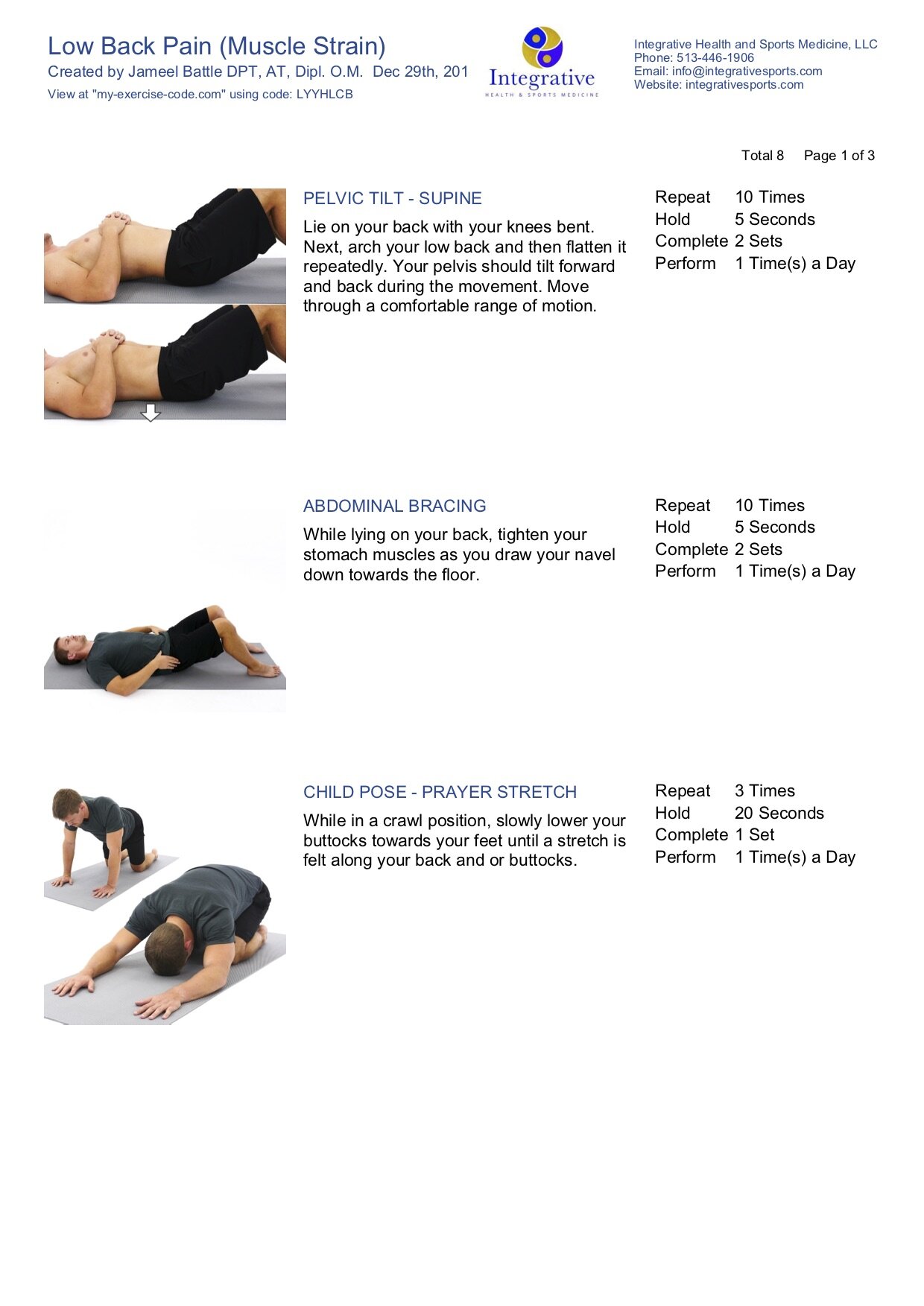HEP: Low Back Pain (Muscle Strain)
Patient Education
What’s going on?
There are many structures that support the back including muscles, ligaments and the joints themselves.
Anyone of these structures can be injured due to lack of sufficient strength, endurance or coordination to perform daily activities.
After a sprain, the inflammation and the pain in the healing tissues can produce tightness in some muscles and weakness in others.
Inflammation and pain are perfectly normal processes and experiences. It is the beginning of healing, so don’t be afraid.
How long will it take?
Most people with lower back pain that recently occurred will recover in six weeks but this can vary depending on the severity of the injury... rest assured the back can heal!
How will we treat your condition at IHSM?
At IHSM, a doctor of physical therapy will perform a detailed physical examination to understand how you move and all the structures that could be contributing to your pain; including the strength and coordination of the muscles around your trunk and hips.
The “core” is a cylinder of muscles that surround your spine like a girdle. The core is composed of your abdominal muscles which make up the sides of the cylinder wrapping around the stomach and attaching to the spine and your back posteriorly. Along with your diaphragm and pelvic floor muscles that make up the top and bottom of the cylinder giving your spine support from all directions.
Your physical therapist will employ a treatment protocol to retrain your muscles to become better at supporting your back and review proper body posture and mechanics to protect your back from getting injured again.
In addition, your treatment may include direction-specific exercises, or manual stretches to help reduce the pain in your leg and back; modalities such as acupuncture, or electrical stimulation may also be used to control the pain in your low back.
What can you do to help yourself?
Acute Phase:
Pay attention to your posture. Keep your spine in neutral position (maintain the natural curve in your low back) during all activities especially getting in and out of the car, going from sitting to standing.
Utilize abdominal bracing or hollowing techniques that your physical therapist explained in all transitional movements.
Use a back brace temporarily as needed to reduce symptoms.
Try your best to avoid the motions and activities that are aggravating but keep an active lifestyle to maintain the mobility you do have as your back heals.
Return to working by modifying the activities that are aggravating.
With proper physical therapy, your back problems can be treated to return you to a pain-free life.
Sub-Acute Phase:
Continue to pay attention to your posture. Keep your spine in a neutral position (maintain the natural curve in your low back) during all activities especially during bending, lifting, and sit to stand activities.
Utilize abdominal bracing or hollowing techniques that your physical therapist explained in all transitional movements.
Perform the exercises that your physical therapist gave you to strengthen your trunk and pelvic muscles.
Keep the joints above and below your lower back moving so they do not get stiff as well. Follow the directions of your physical therapist to perform exercises for your hip, pelvis, and upper back to maintain flexibility.
Chronic Phase:
Understand that elements of pain can be triggered by stress. Do the best you can to reduce the stress in your life particularly relating to your pain. Your tissues are healing and with proper physical therapy, these problems can be treated to return you to a pain-free life.
Remember that tissues heal and it is important to move normally and without fear. Your therapist has taught you some optimal ways to move that will prevent reoccurrence. Remember that your back is a very strong structure designed to allow you to move with freedom and joy!
Perform the exercises that your physical therapist gave you to strengthen your trunk and pelvic muscles.
Keep the joints above and below your lower back moving so they do not get stiff as well. Follow the directions of your physical therapist to perform exercises for your hip, pelvis, and upper back to maintain flexibility.
Instructions:
Exercises that stretch and strengthen the muscles of your abdomen and spine can help prevent back problems. Strong back and abdominal muscles help you keep good posture, with your spine in its correct position.
About IHSM
Integrative Health and Sports Medicine, LLC is a one-stop health and wellness center. Our mission is to restore our patients to a healthy, pain-free, and productive life. By combining orthopedic physical therapy techniques, sports medicine, acupuncture, and Chinese medicine, we can treat conditions and achieve results in cases that have not responded well to modern Western medicine.
We are located in Cincinnati, Ohio. Please email us at info@ihsm.org to schedule a consultation and let us help you on your journey to optimal health.



